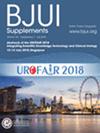Robotic ileal ureter replacement vs kidney autotransplantation for long ureteric strictures
Abstract
Objective
To compare functional and surgical outcomes of robot-assisted ileal ureter replacement (RAIUR) vs robot-assisted kidney autotransplantation (RAKAT).
Patients and Methods
This was a retrospective analysis of patients who underwent RAIUR or RAKAT for long ureteric strictures at eight European tertiary centres (2017–2024). Primary endpoints were maintenance of estimated glomerular filtration rate (eGFR) and postoperative complications within 30 days of surgery, described using the Clavien–Dindo classification. Secondary outcomes included infections, need for lifelong drainage, stricture persistence, and re-intervention for the stricture during follow-up.
Results
A total of 15 and 39 patients underwent RAIUR and RAKAT, respectively. The patients who underwent RAIUR were older (61 vs 45 years, P = 0.03), with more comorbidities (Charlson Comorbidity Index ≥3: 67% vs 28%, P = 0.03) and had a lower baseline eGFR (60 vs 87 mL/min/1.73m2, P = 0.007). The median stricture length was 9.6 cm for RAIUR vs 7 cm for RAKAT. Patients who underwent RAIUR had a shorter surgical time (290 vs 355 min, P = 0.008), whereas those who underwent RAKAT had a shorter hospitalisation (5 vs 8 days, P = 0.001). Overall complications were higher after RAIUR (73% vs 31%, P = 0.01), but Clavien–Dindo Grade ≥III complications were similar (13% vs 10%). During follow-up, both groups showed slightly improved renal function, low infection rates (13% for RAIUR vs 10% for RAKAT), low stricture persistence (13% for RAIUR vs 7.7% for RAKAT), and minimal need for drainage or re-intervention. The main limitation was the modest sample size.
Conclusion
In the first comparative analysis of RAIUR and RAKAT, we provide evidence that both techniques provide similar improvements in renal function and similar rates of postoperative high-grade complications. Both approaches represent definitive solutions for ureteric strictures in most patients. The choice of the technique should be based on patients’ factors, patients’ expectations and the surgeon's experience.

 求助内容:
求助内容: 应助结果提醒方式:
应助结果提醒方式:


